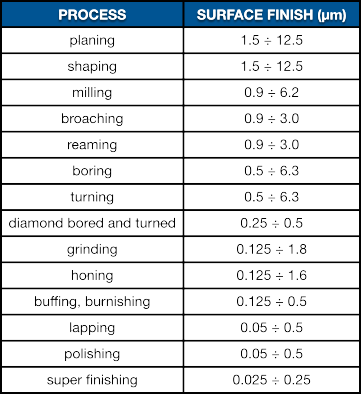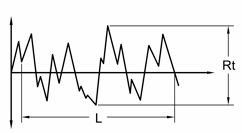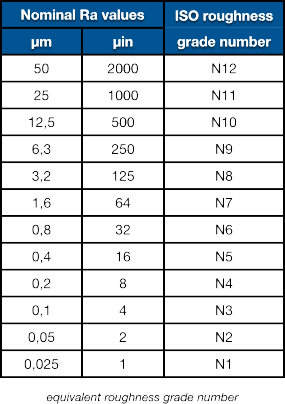The texture of a surface against which a seal rubs has a significant effect on friction, wear and seal life. Texture in this context refers both to surface roughness (or surface irregularities) and to the pattern of these irregularities. The former is capable of sampling measurement. Pattern can only be described empirically, in terms of lay of direction of the dominant pattern, waviness, etc…
The standard method of measuring roughness is by an average value of the profile variation from a centre line over a reference (sampling) length L (see figure). This is know as Centre Line Average (CLA), now commonly expressed as Ra in british Standards and also adopted as ISO standard. In the United States it is designed AA (Arithmetical Average) and in Holland Ru. Most surface measuring instruments give a direct reading of the Ra value, either in micrometers (μm) or micro inches (μin). The ISO standards is μm (1 μm=40 μin and 1 μin=0.025 μm).
ISO R1302 relates nominal Ra values to equivalent roughness grade numbers, which are useful for avoiding misinterpretation of numerical values where different units may be quoted for Ra values.
Surface roughness may also be expressed in terms of maximum roughness, depth or the distance between the peak and the base line measurement over the sampling length (see figure).
Maximum roughness is designed Rt and it is measured in the same units as Ra. Both values can be significant in determining the optimum surface finish required for use with seals.
Recommended surface finishes
The aim of all types of surface finishing is to provide a surface which causes the least wear to the seal.
Rod seals, which seal against moving surfaces, can be damaged by fine abrasive particles which may adhere to a rough surface. Rods should, therefore, have a low surface roughness value, and a surface similar to the hard chrome and a resistance to corrosion. The ideal surface roughness lies somewhere between 0.16 and 0.40 μm (Ra) or 1.0 and 2.5 μm (Rt).
Piston seals, which seal against the inner surface of a cylinder, are not subjected to the same extent to the action of abrasive dirt particles entering from the atmosphere and can, therefore, tolerate a rougher surface. The ideal surface roughness values lies between 0.25 and 0.63 μm (Ra) or 1.6 and 4.0 μm (Rt).
The operating pressure must also be taken into account when evaluating surface properties. At higher operating pressures, the oil film between the seal and the sealing surface is thinner, and the friction is greater. Under such conditions of operation a surface quality which approaches the lower values given should be chosen.
The surface in the seal housing, where the seal is static, should have a surface quality of about 1.6 μm (Ra) or 10 μm (Rt).
Finishes from machining processes
Both the roughness and pattern of the surface finish produced can vary widely with different machining processes. The following table gives typical values likely to be achieved with different processes (but can also be variable depending on the quality of the machine tool and the material being processed).
As an example, optimum seal life with a hydraulic piston rod seal is given when the rod is circular ground (or roller burnished) to a surface finish of better than 0.2 μm (Ra), it should also then be chrome plated and polished.












